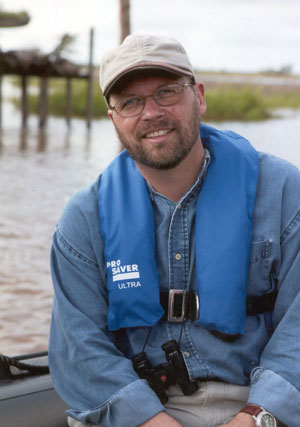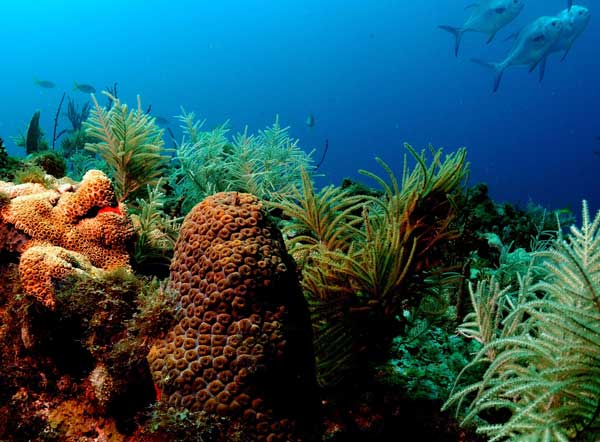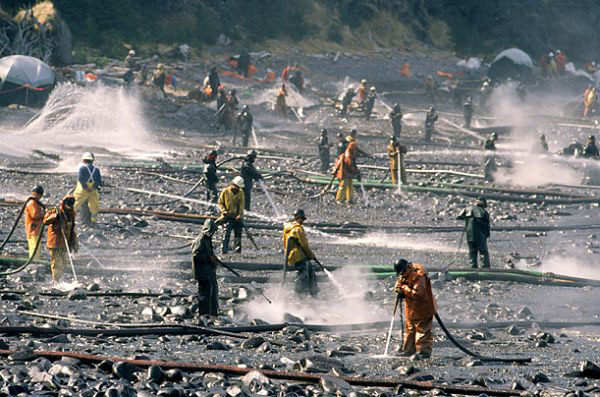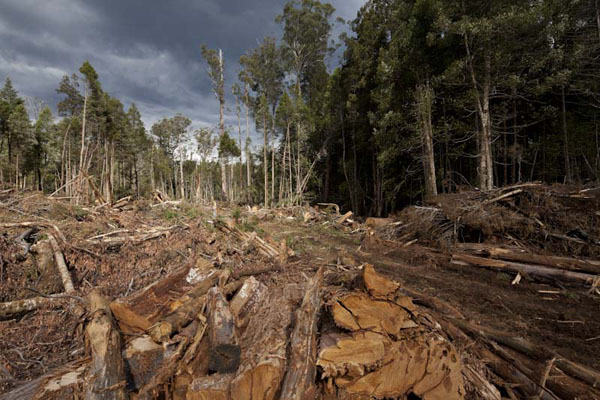News
Interview with Os Schmitz, Oastler Professor of Population and Community Ecology, School of Forestry and Environmental Studies, Yale University
 Image credit: Yale University
Image credit: Yale University
What motivated you and Holly Jones to conduct this research? Was there one particular case of a recovered ecosystem that led you to think other ecosystems could recover with sustained restoration effort?
We got to it in a round about way. Holly is studying restoration efforts on islands off New Zealand. What happened on those islands is that rats invaded and destroyed seabird colonies. The seabirds were an important source of guano for the islands; and the guano sustained ecological function on the islands. Because of the rat invasion, the ecological function was destroyed. What the New Zealanders are actually doing is experimental removal of rats, and they're also trying to attract the seabirds, these colony-breeding seabirds, back to the island in order to restore the ecosystems.
The problem was Holly was measuring the recovery, and the recovery rates seemed to be kind of slow, compared to the duration of field work for a PhD dissertation, which is two or three years. We were wondering how long might we need to monitor these recoveries? We thought it would be a very long time, and it turned out that when we went to the literature and did a synthesis to find out what the benchmark would be, the recovery period, in theory, might actually be very quick for these kinds of systems. It was a bit of a surprise to us to find that, out of the 240 studies, there were a lot of really hopeful signs that things can recover, and recover very quickly. Now, she has the benchmark to go back to her own research and see whether some of these recovery efforts have been running long enough to even say anything about the prognosis of future recovery.
Your research focused on large, human-scale ecosystems as opposed to small scale experiments. Can you define what type of ecosystems were included in the 240 you looked at?
Ecologists, if they're testing out theory, will do experiments with what we call small experimental ecosystems, where we might work on scales of 10-meter-square plots. As you can imagine, those are woefully inadequate to make any kind of inference about the bigger scale human-impacted systems. We as scientists do experiments in small plots to test theory, but, we decided we weren’t going to use those kinds of studies, because they can recover very quickly because of their small size. What we did instead was look at the kinds of ecosystems humans care about and live in. We looked at New England forest ecosystems, for example, and how they recovered after agricultural transformation, or forest recovery after clear cutting in Appalachia. We also looked at seabird-dominated marine systems in terms of recovery after oil spills, like the Exxon Valdez spill, or other major oil spills. We looked at coastlines and forests and how they recovered after hurricanes. We looked at invasive species like rabbits, and, once the rabbits were eradicated, how quickly the land recovered. Prairie restorations, lake clean up. Once the lakes were cleaned up, what did the world look like afterward? There are a whole range of different major ecosystems that humans live in and derive their livelihoods from.
Your research examined variables associated with ecosystems, including nutrient cycling, decomposition rates, and abiotic measurements. Animal and plant community variables included density, diversity, evenness and species composition. Can you explain some of the ecosystem variables in layman's terms? How do you measure at a biological level how an ecosystem's water, soil, air, plant, and animal life is doing?
In the context of sustainability, these are the key variables that society can use to measure sustainable functions. For example, nutrient cycling is really a measure of how the land decomposes organic matter and then creates fertilizer, natural fertilizer (nitrogen or phosphorus or whatever) that comes from decomposed organic matter. What you can do is measure nutrient recycling by taking soil samples. You measure the known amount of nitrogen fertilizer in the soil at the start and then you incubate additional samples for a period of time, and look at how much nitrogen fertilizer accumulates as a consequence of leaf breakdown, due to microbes acting in the soil breaking things down. You use a "before and after" experiment to measure those properties.
In terms of water quality, you just take water samples and subject them to chemical analysis. You can also take leaf material that has fallen off the plants, the plant litter, and you enclose it in little screen bags and set them on the ground, and let the bacteria play their role and decompose the material. It's a before-and-after experiment in which you can measure what was there at the start and then how much was left after a period of time and calculate the rates at which those functions happen. You can then see if the rates speed up over time or if they slow down over time. These are pretty standard biophysical measurements that ecosystem ecologists use all the time.
The only hitch to this is that there is a lot of pluralism in ecology and people have an interest in different kinds of variables in different systems. In coral reef systems, for example, you might want to know how much coral branching is going on during the growth of the coral reef itself, or how much algae is growing on the branches, which would be one variable, whereas in a terrestrial prairie, you would measure the diversity of herbaceous plants. There is some idiosyncrasy in the use of variables within the different ecosystem types, which makes broad comparison a little difficult. That's why we found that people measured 94 different variables. There isn't one single index of ecosystem function that we can use in the same way that maybe an economist might use GDP to measure the health of a market economy. We don't have a single variable to measure the health of a natural economy. That's one thing we're hoping this research spurs -- a better consensus about what key indicator variables we ought to be using across all systems to get a better handle on recovery and sustainability.
 Coral reef / NOAA
Coral reef / NOAA
Are there cases where restoration from environmental damage would take longer than expected, for instance, in the case of chemical waste, logging, or some other type of damage?
What we found is the recovery from a particular damage was independent of the length of the disturbance and also the degree of severity of the disturbance. Recovery was more related to the kind of ecosystem that we were looking at. So, aquatic systems tended to recover more quickly than terrestrial systems. Why? Aquatic systems tend to have smaller organisms, and they develop through life cycles a lot faster in aquatic systems compared to terrestrial systems. A rule of thumb in ecology is that the bigger you are, the longer your life, and the more slowly you reproduce, and therefore the more slowly your population turns over. Terrestrial systems were the slowest to recover because they have long-life trees, as opposed to small algae in aquatic systems. Terrestrial systems have big mammalian herbivores as opposed to the small herbivorous fish in aquatic systems.
The biological reality is that life cycle dynamics largely determines the speed of recovery in a lot of these systems. That said, though, one of the reasons why some ecosystems recovered from oil spills so quickly is because people actively went in and started cleaning things up. They weren't passive about it. When you have major damages like chemical spills or oil spills, people really get engaged quickly to minimize how much damage is caused and the length of the damage period. That's why you see rapid recovery of these heavily damaged systems because humans' will really does kick in.

Oil spill clean up / IMF.org
For example, if we're looking at agriculture recovery, what people usually do there is abandon farm fields and then just let natural processes take over. The fields fill in with natural vegetation over time. It takes a lot longer than if they actively planted trees and afforested these systems. Human agency can enhance the rate of recovery if we want, but natural processes can also take over and still allow recovery within a human generation.
According to your research logging, agriculture, and multiple types of damages (for example, pollution, climate change and logging happening all at once) are the hardest types of damage for ecosystems to get over. Human-caused damages, such as farming or logging, may also be harder to repair than natural causes such as hurricanes or cyclones. Why are human-caused damages more destructive? Given the differences in the damages made by nature and people, do the approaches to restoration also then need to be different?
People transform; they don’t just destroy. When you log and you convert a forest into an agricultural field, what you do is remove one group of species from the land, and you transform that in an altogether new way into a different kind of plant community. In the course of doing that, what you do is remove the seed bank that was naturally there. Trees or herbaceous vegetation may produce seeds every year. Those seeds go into the soil. They lay dormant for a long, long time, and, in some cases, even in aquatic systems, seeds can sprout after 50 or 100 years if the system is left alone. When humans impact the land, and they turn land into some other use, that seed bank is gradually removed too. When agricultural fields are abandoned, there isn't that seed bank to take over again. What you have to do is rely on those original species to slowly invade back into those bare spots, and that takes a lot longer to happen.
 Forest logging / Observetree.org
Forest logging / Observetree.org
For example, a hurricane will knock trees down, but there will still be the understory and the seed bank. A hurricane creates a light gap but it doesn't transform the land. The light gap allows the seed bank to sprout. That's why you can get a speedier recovery after a natural disaster like a hurricane than you can after agriculture. When people have transformed the land base into one kind of use and they want to revert it back to another kind of use, they have to actively help nature along a little bit if they want it to happen quickly. They can also help by restoring the plant species that were originally indigenous to those areas.
Your research found that looking at both water and land systems, land systems took longer to recover. Of land systems, forests take the longest to recover. Are forests somehow more fragile than other ecosystems? What strategies work best for restoring forests?
Forests aren't more or less fragile. Many forests have built-in resiliency, otherwise the logging industry would be completely unsustainable. It's just it that it takes a long time for recovery, as trees are big organisms. They take a long time to grow. It takes 15 to 20 years to get a mature adult tree that can reproduce itself again in a sustainable way. You remove fish from an ecosystem, or you remove algae from an ecosystem -- those algae can reproduce within months and so they fill in a lot quicker, because they're small organisms with a very speedy life cycle. It’s the rule of thumb of biological size and life cycle that makes the difference there. While you can't say one system or the other is more fragile, one system or the other will recover more slowly if we just let nature undergo the recovery on its own.
George Hargreaves, a well known landscape architect working on the re-development of the New Orleans riverfront, mentioned that, particularly in urban areas, there aren't any pristine sites left. Most are all burnt-out, damaged sites. A major focus in contemporary landscape architecture has been to redevelop these post-industrial bombed-out landscapes as parks or networks of parks (green infrastructure), with the goal of designing for both people and habitat. Do you see these types of projects as the way forward for restoring ecological systems in urban areas?
That's probably one of the biggest growth areas for restoration, and I think it's critically important to do these kinds of things, because it kindles a sense of connection to nature among urban people. It’s really important to get them to think that they're part of an ecosystem -- be it an urban or other ecosystem-- rather than simply be drivers of ecosystems. When we restore parks, or when we think about creating green spaces, we have to be careful and get our values in order and identify collectively what it is that we mean by green space. For example, I can imagine that we could restore shrub lands in cityscapes. We could also have small forests throughout cityscapes. But, that may also attract raccoons and coyotes into the city, and you could have urban wildlife problems. When we're restoring these kinds of places, we’ve got to think beyond just aesthetics. We’ve got to think beyond green spaces as being parks and realize that "if we build it they will come:" we will create habitat that attracts species that we prefer but maybe there'll be other species that we don't prefer. It's going to require a bit of a different ethic about what nature and urban nature is if we don't want to fight nature once we've rebuilt it.
Thinking about urban systems as ecosystems that require green spaces to be healthy and functioning is a useful way to go forward, I think. A good example is New Orleans: The mangroves that used to grow there were excellent buffers for hurricanes before there was much settlement. These mangroves were a highly cost-effective way of controlling hurricane damage. When those were removed and the wetlands were removed and the dikes were put in their place, the human built environment became less resilient. The mini-experiment that sort of proved this was a year after Hurricane Katrina hit New Orleans, there was another hurricane of I believe close to or equal in magnitude to Katrina that hit the Yucatan in a tourist area. The people in the Yucatan were really worried that the hurricane was going to destroy a lot of the hotels. But, they still have their mangroves in place. They still had those marshlands in place. These features acted as terrific buffers against that hurricane. The resort areas were spared a lot of damage because nature helped buffer the winds and the tidal surge. Here’s an example of where nature provides an important service to humankind. It isn't about fighting nature and getting rid of nature in favor of built environments. It's the idea that nature can be beneficial to us. The message of our paper is that if we want to think about nature that way, we need to restore. We can be successful in a lot of cases, and in a good many cases we can be quite successful within the time span of a human generation or less.
 Yucatan peninsula mangroves / Mason Lee, Flickr
Yucatan peninsula mangroves / Mason Lee, Flickr
If you were to be strategic about restoring ecosystems where would you put your money? What ecosystems do you think are most valuable?
People have done economic valuation of ecosystems and ecosystem services, and they find that estuarine systems, as well as lakes, forests, and grasslands, are probably, economically, the most valuable to human kind both in terms of our ability to derive our livelihoods from those ecosystems and as providers of earth's support services. So, if you were going to prioritize it based on these sort of economic valuations certainly -- estuaries, forests, grasslands, croplands, and lake systems --would probably be the highest priority to restore.
Oswald J. Schmitz is the Oastler Professor of Population and Community Ecology, School of Forestry and Environmental Studies, Yale University. Learn more about Professor Schmitz's research.
Interview conducted by Jared Green.